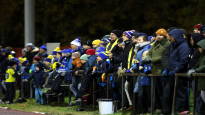Helsinki-based IF Gnistan and Tammisaari-based Ekenäs IF will play in the Veikkausliiga next season. Cities play an important role in renovating clubs’ home stadiums.
On Tuesday, Veikkausliiga granted league licenses for next season to 12 clubs. Among these were Ekenäs IF and Gnistan, who are promoted to the league. In the case of up-and-coming clubs, additional conditions related to the improvement of conditions have been included in the license decisions.
In the case of Tammisaari club Ekenäs, the most important requirement concerns the replaceable grass carpet of the home stadium. In addition, for example, the stadium’s lighting and stands need to be improved.
– The city has budgeted 600,000 euros for renovations and we are supporting the project with 350,000 euros, Ekenäs IF’s director of sports Peter Haglund says.
He states that it is not yet known exactly how much the renovation will cost in the end. The city is currently tendering bids from potential developers of the projects. The field is owned by the city, so the club is only supporting the conditions project.
At the home field of Gnistan, which plays in Oulunkylä, Helsinki, the biggest needs for changes are related to lighting, the field’s irrigation system and the minimum requirement of 1,500 covered stands, which the field currently does not meet.
– Overall, we are talking about an investment in the millions. From 1 million, chairman of the board of Gnistan Antti Uusitalo tells.
With regard to the lights and irrigation system, Oulunkylä is about the city’s infrastructure, but the club is responsible for renovating the stands, for example.
– We are working hard so that in the spring the grandstand capacity is at least double compared to the current one, Uusitalo reveals.
He says that the club has worked closely with the city and believes that the reforms will be organized through it.
Clubs want to serve the public
Both EIF and Gnistan specifically want to increase their auditorium capacity. Haglund and Uusitalo stress that the public’s interest is strong at the moment. In Tammisaari, it is especially about the field’s end grandstand.
– Initially, the capacity increase was planned for 2025, but this is only better. At the end of August at the latest, we will have more capacity and we need it, says Haglund.
Uusitalo says that Gnistan wants to develop the entire Oulunkylä sports park in the coming years. The club carefully weighs what kind of investments will be made for next season, when there is a bigger long-term plan in the background.
The vision is to provide better conditions for different sports and to create another soccer stadium that meets the dimensions in Helsinki.
– We calculate what kind of investment is meaningful now. The final decisions and processes will probably be in motion at the beginning of January, Uusitalo estimates.
Gnistan will have to develop, among other things, locker room facilities, because the city’s sports facilities, which have now been in use, will be renovated starting next spring.
EIF will most likely not start its season in Tammisaari. Haglund says that the turf will be replaced as soon as the weather permits. The field will have artificial turf with heating systems. The planning of the work is now underway.
The number of “Evacko games” depends on the progress of the spring.
– The project depends on the weather. Hopefully, the turf will be replaced in March, Haglund states.
The necessary reforms for both clubs are big, but do not cause great concern among the management. According to EIF’s director of sports, the money going to the field renovation will not affect the club’s operating budget. A number of different supporters are responsible for financing the project.
Uusitalo says that the ownership level of the Oulunkylä club is committed to developing operations. At Gnistan, we think carefully about what the euros are used for.
– If necessary, financing will be organized in such a way that it does not risk operations, the chairman of the board emphasizes.
